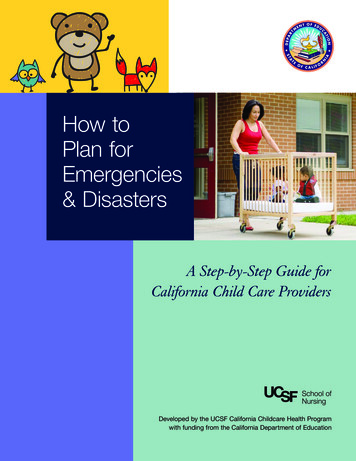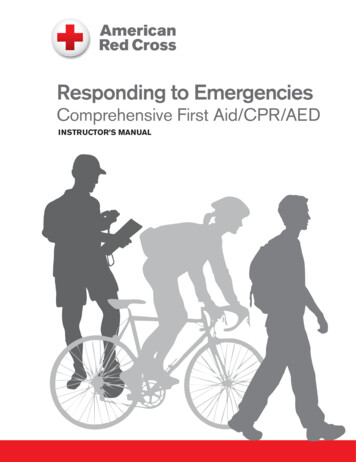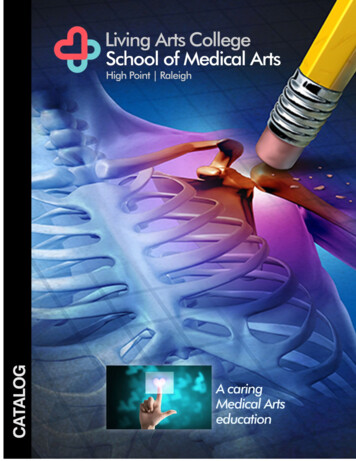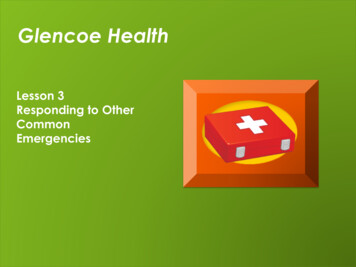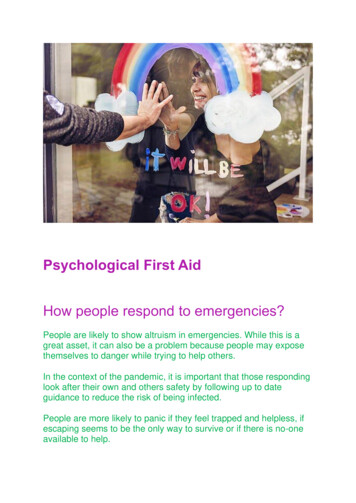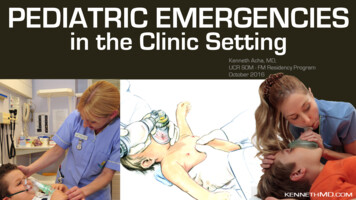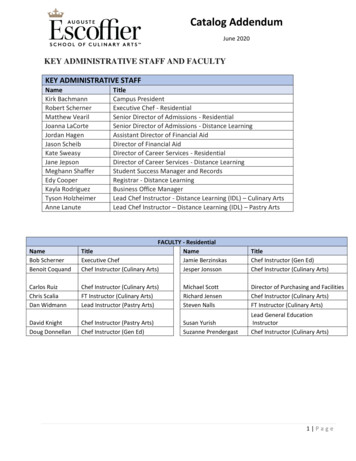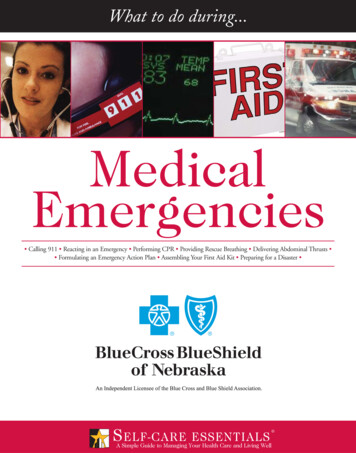
Transcription
What to do during.MedicalEmergencies Calling 911 Reacting in an Emergency Performing CPR Providing Rescue Breathing Delivering Abdominal Thrusts Formulating an Emergency Action Plan Assembling Your First Aid Kit Preparing for a Disaster S ELF-CAREESSENTIALS A Simple Guide to Managing Your Health Care and Living Well
[2]MedicalEmergenciesWhat to do during medical emergencies.When ShouldYou Call 911?When to Call 91115 Conditions1There are times when a medical condition is so severethat it requires immediate, professional, medical assistance. But how can you tell the difference between aminor problem and a medical emergency—especiallywhen minor problems may mimic the early warningsigns of other serious and life-threatening conditions?The following 15 symptoms are signs of seriousmedical emergencies. In an emergency situation, theAmerican Red Cross recommends that you first checkthe scene, then call 911, then deliver care to the victim.In emergency situations, seconds can save lives. Thefollowing 15 symptoms are signs of medical emergencies—call 911 immediately.Shortness of Breath—Your body needs asufficient air supply to provide your vital organsand cells with oxygen for life. Shortness of breathcan be a symptom of a number of serious medicalconditions including heart attack. Anyone who isshort of breath while at rest, or cannot determine thecause of shortness of breath needs immediate medicalattention—call 911.2No Breath or Pulse—If a victim is not breathingor has no pulse, call 911 immediately. To check forbreathing, place your ear above the victim’s mouthto listen and feel for breath, while watching for a riseand fall of the chest. To check for pulse, feel at thefront of the neck for the Adam’s apple. Slide your fingers into the groove next to the Adam’s apple on theside of the neck. If the person has a pulse,you will feel the beat of the blood.If you are unsure that youare feeling a pulse, you can alsolook for signs of circulation.Signs of circulation includecolor in the skin, bodilymovement, and moisture(i.e., perspiration).It is also recommendedthat you request the helpof those around you.Those on the scene maybe able to assist you inperforming CPR (cardiopulmonary resuscitation) ormay be willing to call 911for you, while you assistthe victim.18
[3]MedicalEmergenciesshould always be taken seriously as it offers a physician theopportunity to thoroughly examine the person and discover the source of the pain.3Chest or Upper-Abdominal Pain or Pressure—Chest or upper-abdominal pain or pressure can be asign of a serious, life-threatening issue—especially ifthe pain spreads to the neck, arms, and jaw. In fact, theseare classic signs of a heart attack. A heart attack occurswhen blood flow to a portion of the heart is restricted.Seeking emergency medical attention immediately is vitalif an individual is suffering from these symptoms. In fact,studies show that 75 percent of people survive heart attackswith little or no heart damage if they seek emergency carewithin 60 to 70 minutes of the onset of symptoms.8Bleeding That Can’t Be Controlled—Mostbleeding should stop within a few minutes if directpressure is applied to the wound. If a wound bleedsprofusely for more than four to five minutes, call 911.After calling 911, attempt to stop the bleeding byelevating the wound and applying direct pressure to itwith a clean cloth until medical help arrives.4Unconsciousness—Emergency situations thatinvolve a loss of consciousness are always serious.And because the causes of unconsciousness includeheart attack, head injury, stroke, diabetes, or shock—justto name a few—an unconscious person always needsimmediate, emergency medical attention—call 911.Conditions 9 through 15 continued on the following page.5Possible Spinal or Neck Injury—Neck or spinalinjuries can result in paralysis. If you suspect apossible neck or spinal injury, DO NOT attemptto move the victim unless he or she is in grave danger.Injuries to the neck and spine can be made worse if thevictim is moved without the help of trained emergencymedical personnel—call 911.6Disorientation—Disorientation can be the sign ofmany serious medical conditions. An individual whobecomes disoriented after previously being alertshould seek emergency medical care immediately. You mayassess someone who’s disoriented by asking three simplequestions: What day is it? Where are you? And, what’syour name? A person who cannot remember their name isusually in the most serious danger. Regardless of how thequestions are answered, anyone who suddenly becomesdisoriented needs immediate, emergency care—call 911.7Sudden Severe Pain—Although sudden, severe painmay not necessarily indicate a serious medical condition, it should be treated as an emergency, if for noother reason than to relieve the pain. Level of pain, too, issubjective, but if an individual complains of sudden, severepain—the worst pain they have ever experienced—it“There are over 100 million visits to hospital emergency roomseach year in the United States.”19
[4]MedicalEmergenciesWhat to do during medical emergencies.When ShouldYou Call 911?Continued.mention a few. Sometimes it can be difficult totell the difference between coughing or vomitingup blood, but it matters little—call 911 if you arecoughing or vomiting blood.9Severe or Persistent Vomiting—Vomiting is yourbody’s way of getting rid of toxic and potentiallyharmful substances. Severe or persistent vomitingcould be a sign of poisoning, overdose, or Reye’s syndrome in children. Additionally, severe or persistentvomiting can quickly result in dehydration.If an individual is vomiting continuously, or if thevomiting is excessively violent, call 911.11Major Injury or Trauma—Commonsense will normally tell us when an injuryis traumatic enough to seek emergencymedical care. Obvious examples of major injuriesinclude broken bones, gun shot wounds, deep cuts,head injuries, etc. If you have doubts as to whetheran injury is serious enough to warrant emergencymedical care, it is far better to be safe than sorry. Ifyou are unsure, or have any doubts about your condition, seek medical careimmediately—call 911.10Coughing or Vomiting Blood—Coughing or vomiting blood can be asign of a serious medical conditionincluding lung cancer, heart disorders, pneumonia,or tumors in the stomach or esophagus, just to12Feeling ofImpendingDoom—It isnot unusual for individualsexperiencing serious medicalconditions to feel a senseof impending doom. Thisis especially true duringtraumatic experiences likeheart attacks. In fact, asense of impending doomis a key symptom of a heartattack and other seriousmedical conditions. Trustyour instincts—if you feel asense of impending doom,get emergency medical careright away—call 911.20
[5]MedicalEmergencies13Sudden Vision Changes or Loss—A suddenchange in vision or vision loss can indicate anumber of serious conditions including retinaldetachment, sudden glaucoma, stroke, or any number ofsystemic eye diseases. In some cases, a sudden change orloss of vision may be irreversible if emergency medicalattention is not sought immediately—call 911.EMERGENCYNUMBERS14Suicidal or Homicidal Feelings—Anytimean individual experiences suicidal or homicidalfeelings, immediate, emergency medical careand intervention should be sought. Doing so can helpprevent unnecessary loss of life for the individual or thosearound them. Such feelings may indicate the presenceof depression or other mental disorders, many of whichare very treatable—nevertheless, call 911.Emergency Services911National Poison Control1-800-222-1222Family PhysicianPediatrician15If You Are Unsure About What to Doin An Emergency Situation—It’s oftendifficult to differentiate between minorand major medical conditions. Both serious and minorconditions may share similar symptoms that easilyblur the line between them. If you’re ever in doubtwhether a condition is serious or not, or if you areunsure about how to treat a condition, it’s importantto seek the assistance of emergency medical personnel—call 911.!Close Relatives/FriendsNurse Lines/OtherAddress of Local HospitalKey Point: Resist the urge to transport any personexperiencing a medical emergency in your own vehicle.Instead, call 911 and follow any instructions given.“Approximately 268,000 calls are made to emergency services (911)each day in the United States.”21
[6]MedicalEmergenciesWhat to do during medical emergencies.What To Do InAn EmergencyEmergency Situations1Check The Scene And TheVictim—When coming upon an emergency,During an emergency situation, how you react, andhow you care for the injured individual, can mean thedifference between life and death. Do you know howto respond in an emergency?it’s important to check the surrounding area forsafety, as well as to check a victim’s condition. Fourmain questions will help you do this most effectively.These questions are:3333The 3Cs For ReactingTo An EmergencyThe three basic steps to responding to a medicalemergency include checking the scene and the victim,calling 911 or other emergency services, and caring forthe victim. Let’s take a closer look at each step.Is the scene safe?What happened?How many victims are there?Can bystanders help?Assessing the scene for safety means quickly scanningthe area to search for objects or dangerous situations thatstill remain. If you determine that the scene is unsafe,DO NOT INTERVENE—call 911 immediately.If the scene is safe, check the victim. Try todetermine what happened by speaking with the victim. If the victim is unconscious, try to gather asmuch information about the emergency and thevictim’s condition as possible—assess the scene andask bystanders for input. This information is criticalto emergency services personnel. Also, don’t forgetto look for additional victims, and never be afraid toask bystanders for help.2Call 911—Calling 911 may be the mostimportant thing you can do when youencounter an emergency medical situation.It is preferable, if possible, to have a bystander call911, so you can remain with and care for the victim.(Refer to the section entitled, When Should You Call911? for more information).22
[7]MedicalEmergenciesIf possible, have a bystander call 911 duringan emergency, so you can stay with the victim.When calling 911, be prepared to give the dispatcherthe following information:3333333!Airway—If there is no trauma, check the person’sairway by tilting the head and lifting the chin. Ifthere is trauma, with index finger and thumb, lift forwardon the person’s jaw.State the location of the emergencyIf possible, give the dispatcher the phone numberyou’re calling fromState your nameTell the dispatcher what happenedTell the dispatcher how many people are involvedExplain the condition of the victim(s)Tell the dispatcher what, if any, first aid is being givenBreathing—Is the person breathing? To check forbreathing, place your ear above the victim’s mouth tolisten and feel for breath, while watching for a rise and fallof the chest. If there is no breathing, give two breaths. Ifthe chest still does not rise, reposition the head and giveone more breath. If the chest still does not rise, giveabdominal thrusts. (see Abdominal Thrusts section)Circulation—Does the victim have a pulse? To checkfor pulse, feel at the front of the neck for the Adam’sapple. Slide your fingers into the groove next to theAdam’s apple on the side of the neck. If the person has apulse, you will feel the beat of the blood.Key Point: Do not hang up the phone until the dispatcher hangs up or until you are instructed to hang up.3Care For The Victim—If the victim is con-If you are unsure that you are feeling a pulse, youcan also look for signs of circulation. Signs of circulationinclude color in the skin, bodily movement, and moisture(i.e., perspiration).scious, the American Red Cross suggests that you tellthe victim who you are, share with them how youwill attempt to help them, inform them as to how muchtraining you have, and ask for permission to care for them.If the victim refuses care, respect their wishes, and wait foremergency care to arrive. If the victim desires care, beginfirst-aid procedures as appropriate (see the ABCs in thissection). If the victim is an unconscious adult, permissionto care for the victim is implied. If the victim is a child andno guardian can be found, permission to care for him orher is implied. Otherwise, permission must be sought fromthe child’s supervising adult.The status of the victim’s airway, breathing, andcirculation, will determine the type of care you provide—CPR, rescue breathing, or abdominal thrusts may benecessary. See the following pages for information onthese procedures.If you come across an unconscious individual, carebegins with a critical assessment. This assessment evaluatesthe victim’s ABCs—Airway, Breathing, and Circulation.“In an emergency, remember the Three Cs:Check the scene and the victim, Call 911,and Care for the victim.”23
[8]MedicalEmergenciesWhat to do during medical emergencies.Giving CPRAbout Giving CPRAirway—If there is no trauma, check the person’sairway by tilting the head and lifting the chin. Ifthere is trauma, with index finger and thumb, lift forward on the person’s jaw.CPR can be an important process for helping to ensurethe survival of a victim whose heart has stopped beating.When the heart stops beating (known as cardiac arrest)breathing also stops, and without CPR and immediatemedical attention, it’s likely that the victim will die.Breathing—Is the person breathing? To check forbreathing, place your ear above the victim’s mouth tolisten and feel for breath, while watching for a rise andfall of the chest. If there is no breathing, give two breaths.If the chest still does not rise, reposition the head andgive one more breath. If the chest still does not rise, giveabdominal thrusts. (see Abdominal Thrusts section)CPR involves the combination of rescue breathingand chest compressions to circulate oxygenated blood tothe brain and other vital organs. Although CPR isn’t aseffective as normal respiratory and cardiovascular functioning, it’s an important lifeline during an emergency.Circulation—Does the victim have a pulse? To checkfor pulse, feel at the front of the neck for theAdam’s apple. Slide your fingers into the groove next tothe Adam’s apple on the side of the neck. If the personhas a pulse, you will feel the beat of the blood.Before You BeginBefore performing CPR on a victim who appears tobe unconscious, gently shake the individual, asking ifthey’re OK. If the victim is unresponsive, shout forhelp or call 911.If you are unsure that you are feeling a pulse, youcan also look for signs of circulation. Signs of circulationinclude color in the skin, bodily movement, and moisture (i.e., perspiration).While waiting for emergency services to arrive—andprior to performing CPR—it’s important to perform acritical assessment. This assessment evaluates the victim’s ABCs—Airway, Breathing, and Circulation.If the victim has a pulse, DO NOT perform CPR.Performing CPR on a victim whose heart is beating cancause serious damage. If the victim is not breathing, buthas a pulse, perform rescue breathing (refer to the nextsection). If the victim has no pulse, and is not breathing, it’s time to begin CPR.If the victim is breathing and has a pulse, but isunresponsive, and has not experienced serious trauma,place the victim on their side. This is known as therecovery position.In a medical emergency, remember your ABCs—Airway, Breathing, and Circulation.ABCs24
[9]MedicalEmergenciesPerforming CPRStep 1Step 1: Place the victim on their back, tilting theirhead backwards to open breathing passages.Step 2: Give rescue breaths. It is recommended thatyou use a face shield or pocket mask to give rescue breaths.Pinch the victim’s nostrils closed if necessary. If you do nothave a face shield or pocket mask, you may choose to perform chest compressions only (see step 3 below). Providetwo full breaths to the victim. If the chest does not risewhen you deliver these breaths, you may have missed anitem blocking the victim’s airway. Reposition the head anddeliver one more breath. If the chest still does not rise, perform abdominal thrusts. (See Abdominal Thrusts section).Step 2Step 3: Begin giving chest compressions by positioning your hands over the lower part of the victim’s breastbone, where the ribs and breast bone meet. Position yourbodyweight over your arms (do not bend your elbows)and use your upper bodyweight to compress the chestapproximately two inches. After compressing the chest15 times, deliver two more rescue breaths.Step 4: You must administer four complete cycles of15 chest compressions and two breaths before rechecking for breathing and pulse. Deliver compressions at arate of 100 per minute. If there is no pulse or breathingafter one minute (four complete cycles of 15 compressionsand two breaths), continue delivering four more completecycles of 15 chest compressions and two breaths—checking for pulse and breathing at one minute intervals—untilmedical personnel arrive.Step 3When To StopGiving CPRStep 4There are only a few situations when it’s appropriate tostop giving CPR. They are as follows.repeat the cycle1. If the victim’s heartbeat and breathing resume.2. If another trained person takes over CPR for you.3. If emergency medical services (EMS) personnelarrive and take over care of the victim.4. If you are exhausted and are physically unableto continue.5. If the scene becomes unsafe.“Seventy-five percent of all out-of-hospital cardiac arrestsoccur in the home. Learning CPR can save a life.”25
[10]MedicalEmergenciesWhat to do during medical emergencies.RescueBreathingAbout RescueBreathingPreventing Disease TransmissionDuring an emergency, when blood or otherbodily fluids are present, there is an increasedrisk of disease transmission. The best way toprevent exposure to disease is to be prepared. Stockyour first aid kit with items that can reduce the chanceof exposure to bodily fluids. These items include:Rescue breathing is given to someone who is unconscious and not breathing, but DOES have a pulse. Inan emergency such as this, you must provide air to thevictim, so that he or she can stay alive.3 Disposable gloves 3 Eye protection3 A face shield or pocket mask (for rescue breathing)Giving RescueBreathingStep 3: After providing two breaths,To give rescue breathing, follow the four steps listed here.check for a pulse. If the victim has apulse, but isn’t breathing, continueproviding one breath every fiveseconds. After 10 to 12 breaths,recheck the victim’s pulse. (If,during rescue breathing, you discover the victim has no pulse orno signs of circulation, provideCPR—see previous section).Step 1: If you suspect a person is not breathing,place the victim flat on their back, tilt theirhead back, and lift their chin so that thetongue moves away from the back of thethroat. If there is trauma, with index fingerand thumb, lift forward on the person’sjaw. Place your ear above the victim’smouth to listen and feel for breath,while watching for a rise andfall of the chest, indicatingbreathing. If, after five seconds,the victim isn’t breathing, you’llneed to perform rescue breathing.Step 4: Continue rescue breathing, rechecking fora pulse every 10 to 12 breaths.When to Stop Rescue Breathing33333Step 2: Pinch the victim’s noseclosed and form a tight sealaround their mouth with yourbarrier device. Provide twobreaths each lasting 2 seconds. (Ifthe victim’s chest does not rise, theairway is likely blocked. Reposition thehead, deliver one more breath. If thechest still does not rise, perform abdominal thrusts—see the next section).If emergency medical personnel arriveIf the person begins breathing on their ownIf someone takes over rescue breathing for youIf you are physically unable to continueIf the scene becomes unsafeThe best preparation for an emergency situation is toget certified in first aid and CPR. Contact the AmericanRed Cross to find out how you can get certified.Source: American Red Cross“Pinch the victim’s nose closed and form a tight seal around their mouth withyour barrier device. Provide two breaths each lasting 2 seconds.”26
[11]MedicalEmergenciesAbdominalThrustsGiving AbdominalThrustsGiving Abdominal Thruststo an UNCONSCIOUS VictimStep 1: If a person is unconscious and not breathing,Abdominal thrusts are commonly performed whenan individual is choking. Look at the procedures belowto learn how you can help a choking person.dial 911 before providing care.Step 2:Giving Abdominal Thrusts to aCONSCIOUS VictimStep 1: Do not begin rescue procedures if a victimPlace the victim on their back. Straddle thevictim’s legs, placing the heel of one ofyour hands on the middle of theabdomen just above the navel.Step 3:Place your otherhand on top of your firsthand with fingers pointedtowards the victim’s head.Give five quick thruststowards the head andinto the abdomen.can speak, cough, or breathe. Instead, encourage thevictim to continue coughing. If a person continueschoking, dial 911 immediately. If the airway becomescompletely blocked (victim cannot speak, cough, orbreathe) begin abdominal thrusts.Stand behind the victim,wrapping your arms around theirwaist. Make a fist with one hand,placing the thumb-side against thevictim’s abdomen above the naveland below the rib cage.Step 4: After fivethrusts, check the victim’smouth for the obstruction and remove it if possible.Repeat thrusts until object is dislodged or emergencypersonnel arrive. After the item is dislodged, providefurther care such as rescue breathing or CPR if needed(see previous sections).Step 3: Grab your fist with yourother hand, giving quick, inward,and upward thrusts. Repeat untilthe object is cleared.Giving Abdominal Thrusts To YourselfStep 1: Position a fist just above the navel.Step 2:Step 2: Grab your fist with your other hand andthrust upward into your abdomen until the object isexpelled. Leaning over a chair will produce the same effect.!!Key Point: After any choking incident, the victimshould visit the ER for follow up care.Key Point: Chest thrusts should be used in place ofabdominal thrusts on pregnant females.Source: American Red Cross27“Approximately 3,000 people die eachyear from choking—many of thesedeaths can be avoided by performingabdominal thrusts.”
[12]MedicalEmergenciesWhat to do during medical emergencies.Your EmergencyAction PlanSeconds Save LivesPreparing for EmergenciesEven with efforts to prevent emergencies, occasionallythey still occur. Prepare yourself for emergencies in thefollowing ways:By their very nature, medical emergencies happenquickly and without warning. Having an action plan,the right tools and resources, and arming yourself withkey pieces of knowledge can mean the differencebetween life and death when seconds count.! Keep a well-stocked first aid kit at home, at work, andin your car (see the following section for contents)! Understand what constitutes an emergencyYour emergency action plan should include fourkey elements—prevention, preparation, recognition,and decision-making.(Refer to the section entitled, When Should YouCall 911? for more information).! Keep written records of important medical information! Take a first aid and CPR class! Post emergency numbers near your telephonePreventing EmergenciesYou and your loved ones can reduce the likelihoodof medical emergencies by, first and foremost, stayingup-to-date on medical exams and checkups.You should also:u Always wear a seatbeltu Eat a balanced dietu Follow safety instructions when cooking,Recognizing EmergenciesSome situations require emergency medical care—in the following instances, call 911:1. Shortness of Breath2. No Pulse or Breath3. Chest or Upper-Abdominal Pain or Pressure4. Unconsciousness5. Possible Spinal or Neck Injury6. Disorientation7. Sudden Severe Pain8. Bleeding that Can’t be Controlled9. Severe or Persistent Vomiting10. Coughing or Vomiting Blood11. Major Injury or Trauma12. Feeling of Impending Doom13. Sudden Vision Changes or Loss14. Suicidal or Homicidal Feelings15. If You Are Unsure About What to Doworking outside, etc.u Wear protective gear (helmets, pads, etc.)u Never drink and driveu Avoid all tobacco productsu Exercise regularlyThe importance of planning.Studies show that in an emergency,lives are either saved or lost withinthe first six minutes.28
[13]MedicalEmergenciesKeeping EmergencyInformation At HandEMERGENCYWhen an emergency strikes, there’s little time to react.Having important information such as key phonenumbers or emergency instructions at hand during anemergency can save valuable time when seconds count.A chart for keeping track of important phone numbershas been included on this page.NUMBERSEmergency Services911In addition to important emergency contacts, otherimportant information and medical forms should be kepton hand and ready for emergency personnel. Forms tokeep on hand include:National Poison Control1-800-222-1222Family Physician Medical Treatment Consent Forms—A medicaltreatment consent form designates a specific personto make important medical decisions for a minor whenparents/guardians are unavailable.Pediatrician Emergency Information for Children with SpecialClose Relatives/FriendsNeeds—This information typically outlines anychronic conditions a child may have, as well asspecific allergies, and prior medical history.Nurse Lines/Other Personal Medical History Form—By providingemergency services personnel with a medical history,valuable time may be saved, and mistakes may beavoided.Address of Local Hospital Medical Contact Form—In the case that you or aloved one is injured, having a medical contact formsaves emergency services personnel valuable time innotifying family members.Deciding to ActIn an emergency, time is critical. When secondscount, one of the most important things you can dois to make the decision to help out. Whether it’scalling 911, comforting a victim, or providing lifesaving care, making the decision to act may be justas important as knowing what to do. If you don’thelp, who will?“When seconds count, one of the mostimportant things you can do is to makethe decision to help out.”29
[14]MedicalEmergenciesWhat to do during medical emergencies.AssemblingA First Aid KitWhat to Include inYour First Aid KitHaving a well-stocked first aid kit will enable you andyour family to respond appropriately when faced withan emergency. The American College of EmergencyPhysicians recommends that you keep the followingitems in your first aid kit:::A first aid manual:A list of allergies (a separate list for each householdmember)Emergency phone numbers and information(see previous section):A list of prescribed medications (a separate list foreach household member):Pain relievers (acetaminophen, ibuprofen, andaspirin—keep at least two tablets of aspirin at alltimes in case of heart attack):Cough suppressant:Antihistamines:Oral medical syringe (to administer medicationto children):Fluids to use for oral hydration when treatinginfant diarrhea (Pedialyte or Infalyte)::Bandages of assorted sizes:Elastic wraps (to wrap wrist, ankle, knee, andelbow injuries):::::::::Gauze in rolls and gauze pads in 2 and 4 inch sizes!Key Point: Remember to keep a first aid kit in thethree most common places you’ll need one—atwork, at home, and in the car.Triangular bandages (to wrap injuries or createan arm sling)Disposable, instant-activating cold packsSharp scissors with rounded tipsSafety pinsAntibiotic ointmentHydrogen peroxideRubber glovesPetroleum jellyHydrocortisone cream::::::Antiseptic wipesAdhesive tapeTweezersThermometerCalamine lotionDecongestantsSource: The American College ofEmergency Physicians30
[15]MedicalEmergenciesPreparing ForA Disaster2Make a Family Communication Plan. If an emergency or disaster strikes, be sure everyone in yourfamily is prepared and knows what to do. Considerthe following items as part of your communication plan:Your emergency supply kitshould last at least threedays. Don’t forget the mostimportant item: water. Make sure family members can stay in touch duringan emergency or disaster—regardless of location. Include out-of-state friends or relatives in yourcommunication plan. Keep emergency numbers near the phone and withDisaster Preparednesseach family member.Emergencies and disasters are an unfortunate part of life.You can increase your comfort and chances of survivalduring an emergency or disaster by taking three key stepsnow, before a disaster strikes. Select a “safe room” where the family will meet during adisaster or emergency. An interior room, above ground,with few doors and windows is the best choice. If the house is unsafe (in the case of a fire for example),choose a safe location outside the house in which to meet.Three Steps to Disaster Preparedness1Assemble an Emergency Kit. An emergency kitshould enable you to survive comfortably for at leastthree days, until after a biological, radiological, orchemical attack/emergency has passed. You’ll need: Water Canned/dried food Warm blankets Battery powered radio First aid kit Map of the area Cell phone/extra battery Photo ID Utility knife/pliers3Continually Prepare. Continually preparing andpracticing for disasters and emergencies will betterensure your survival and health during an emergency or disaster. Keep the following in mind as youcontinually prepare for emergencies and disasters: Flashlight A change of clothes Plastic garbage bags Extra batteries Duct tape Whistle Cash and credit card Spare car keys Waterproof matches Practice and revise your disaster communication plan Seek out news stations that will be helpful in case ofan emergency Become certified in first aid and CPR Replace supplies after they are used or expire Be familiar with your insurance policiesSource: US Department of Homeland Security“Select a ‘safe room’ where the family will meet during a disaster or emer
medical emergencies. In an emergency situation, the American Red Cross recommends that you first check the scene, then call 911, then deliver care to the victim. In emergency situations, seconds can save lives. The following 15 symptoms are signs of medical emergen-cies—call 911 immediately. 15 Conditions 1 Shortness of Breath—Your body needs a
